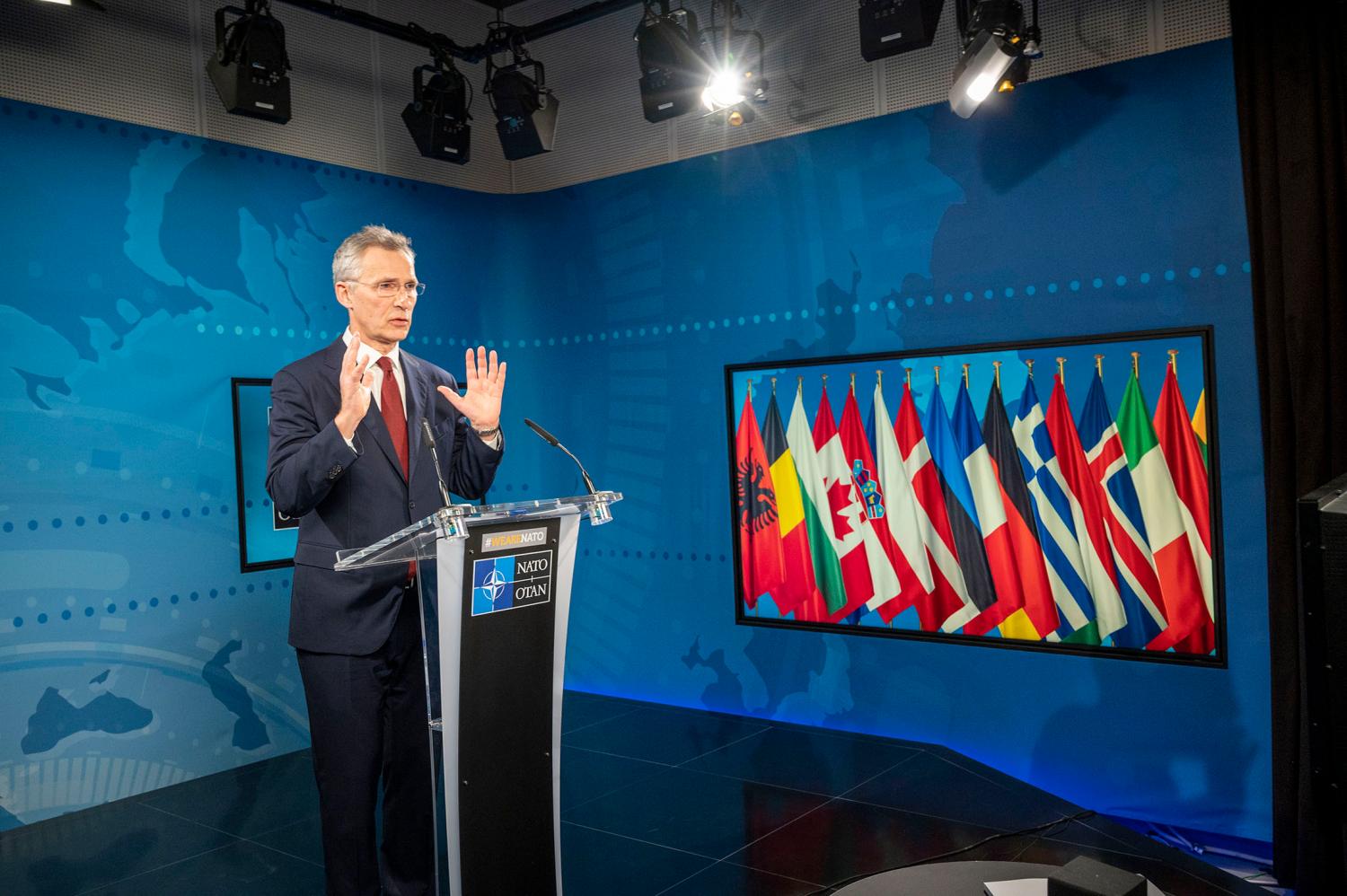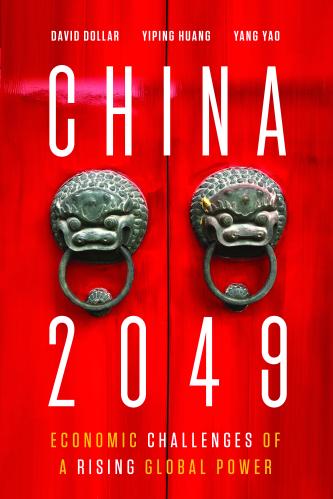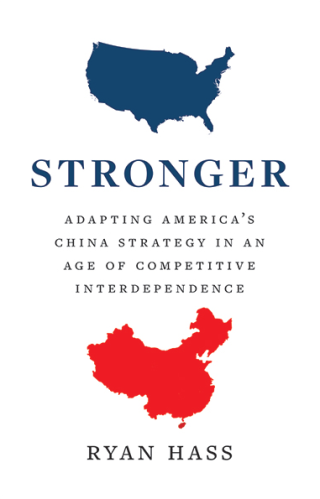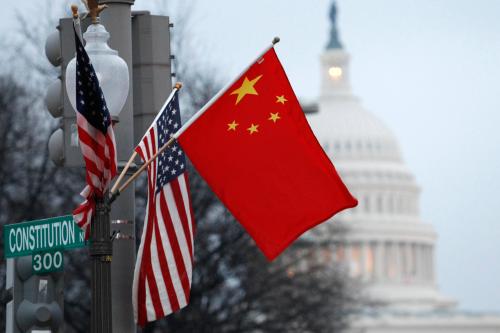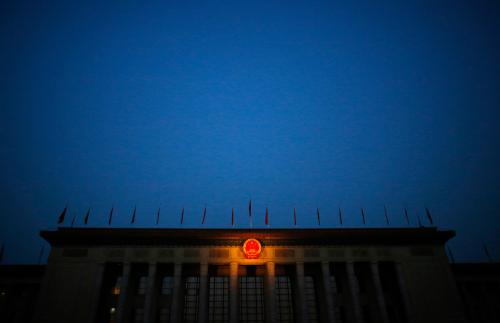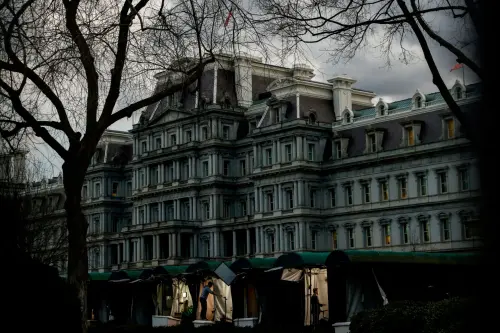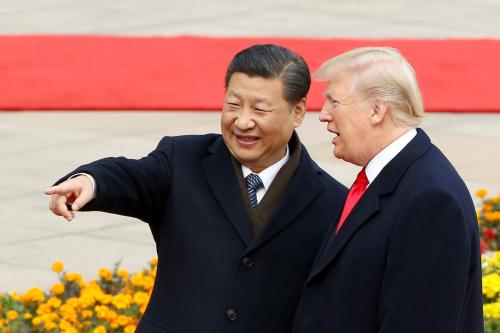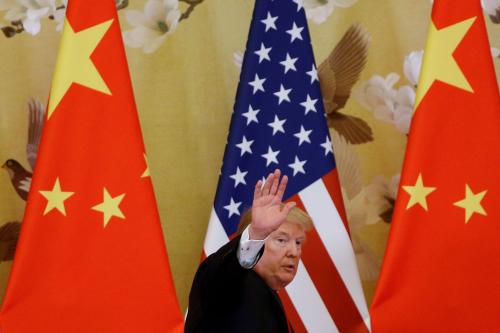This brief is part of the Brookings Blueprints for American Renewal & Prosperity project.
Contents
- Summary
- Challenge
- Evolving alliance trends
- Fault lines underneath
- Three key questions
- Policy recommendations
- Conclusion
Summary
America’s alliance network has been one of the most enduring and successful elements of U.S. foreign policy since World War II. U.S. alliances have continually adapted and evolved in the post-Cold War era, but they now face a new, more formidable challenge: collectively responding to China’s growing economic, military, and technological influence. This task is the central geostrategic challenge facing the United States and its allies, but U.S. alliances are not currently postured, either strategically or operationally, to manage it. U.S. allies in both Europe and the Indo-Pacific have begun to more seriously consider the challenges posed by Beijing, but China is leveraging its economic prowess to exploit both domestic and international fissures within the alliance network. Looking ahead, the United States and its allies must begin to confront the task of deterring Chinese coercion — both military and economic — as a multilateral task. This paper argues the United States should focus on: establishing new multilateral forums and linkages between European and Indo-Pacific allies; refocusing U.S. allies on domestic resilience and collective defense of their own regions; establishing deeper interoperability not only in the military domain, but also in non-kinetic arenas; and pooling allied innovation advantages to counter China’s growing technological influence.
Challenge
The U.S. alliance network has been one of the most successful and enduring aspects of American foreign policy over the past 70 years. These alliances, originally designed to contain possible Soviet expansion, have adapted and evolved in the post-Cold War era. Together, the United States and its democratic allies possess an overwhelming economic and military advantage over any possible competitors. The top ten largest economies measured by nominal GDP include the United States (1), Japan (3), Germany (4), the United Kingdom (6), France (7), Italy (8), and Canada (10). While China’s estimated military spending increased by 85% over the past decade, U.S. allies (NATO plus Australia, Japan, and South Korea) still comprise approximately 60% of global military spending.
U.S. allies are not of one mind regarding their relationships with China, nor in many cases are they united with Washington about the best way to manage China’s behavior. Beijing has exploited these fissures within and between allies repeatedly.
America and its allies together, therefore, are in a strong position to confront the central geostrategic challenge facing them in the coming decades — namely, China’s growing economic, military, and technological capabilities and influence. Given China’s aggressive behavior in the Indo-Pacific region, America’s relationships with leading Asian democracies are already focused on this problem. But even NATO has begun to consider how the trans-Atlantic alliance can contribute to this effort. Unfortunately, U.S. allies are not of one mind regarding their relationships with China, nor in many cases are they united with Washington about the best way to manage China’s behavior. Beijing has exploited these fissures within and between allies repeatedly.
Dealing with the alliance-management problems posed by Beijing would be challenging for America and its allies under the best of circumstances. The impact of COVID-19 only makes the situation more difficult. As citizens seek protection from current and future health crises and governments grapple with recessionary pressures on defense budgets and government spending, the tensions between China’s role as a needed partner and a formidable competitor will only become starker. Can the U.S. alliance network be repurposed once again to successfully manage this challenge? This paper explores this question and offers a set of recommendations for the new administration.
Evolving alliance trends
The downturn in U.S.-China relations over the past four years has been swift and sharp. In 2015, the Obama administration’s National Security Strategy advocated for a “constructive relationship with China,” referring to cooperation between the two countries as “unprecedented” in scope. By 2017, the Trump administration’s National Security Strategy pointed to China as a “competitor” and a “revisionist power” seeking to “erode American security and prosperity.” This seemingly abrupt transition reflects more than a shift in administrations. It also reflects a hardening view of China that has become a rare point of bipartisan consensus in Washington, despite differences between Democrats and Republicans over how best to prosecute an effective China strategy. Recent polling suggests that public opinion is beginning to follow elite sentiment. An October 2020 Chicago Council on Global Affairs survey notes that for the first time since 2006, more Americans prefer a policy that “actively work(s) to limit the growth of China’s power” rather than one of “cooperation and engagement.”
Similar though more muted shifts are underway in key allied capitals. The European Union’s 2019 EU-China Strategic Outlook refers to Beijing not only as a “cooperation partner,” but also as an “economic competitor” and “systemic rival.” As our Brookings colleague Tom Wright has observed, while this language is “far softer and more benign than any imaginable U.S. approach,” it marks a notable toughening of European rhetoric. In Asia, ties between Tokyo and Beijing remain frosty, as Chinese maritime aggression around the Senkaku Islands drives new Japanese defense investments and military cooperation with both India and Australia. Perhaps the most dramatic downturn in bilateral ties has occurred in Canberra, where Beijing has responded to simmering political tensions by slapping tariffs on approximately $20 billion of Australian exports, including barley, coal, wine, and seafood.
Fault lines underneath
Notwithstanding general convergence toward a tougher China policy in the U.S. and many allied capitals, divergent economic and political interests remain hindrances to a cohesive allied approach toward Beijing. Three important fault lines include:
Domestic debates: Within the U.S. and other democratic nations, domestic interest groups remain polarized over how best to manage the China relationship. Disagreements over how broadly trade and technology restrictions should extend, how openly to criticize Beijing’s political and human rights violations, and how to manage territorial grabs in the South China Sea have created fissures among political and business leaders. In Australia, the Morrison government has come under fire for being unnecessarily provocative toward China; meanwhile, in Germany, even some of Chancellor Angela Merkel’s party colleagues have criticized her for being too soft. The Trump administration faced pushback from both the technology and agricultural sectors for its management of the bilateral economic relationship. In the Czech Republic, a 2020 visit to Taipei by the leader of the Senate sparked a furious rejoinder from Beijing and was derided by President Miloš Zeman as a “boyish provocation.” China has in many cases fostered and exploited these divides, deploying targeted economic threats and inducements in a bid to sway democratic decision-making, establishing “friendship groups” aimed at cultivating supportive business and cultural elites, and leveraging Chinese diaspora communities to advocate for Beijing’s preferred positions.
Public opinion is clearly shifting against China in most, but not all, of the major U.S. allies. The number of those holding a favorable opinion of China has increased in Poland and Italy, but dropped precipitously elsewhere, providing opportunities for achieving greater consensus about the need to combat Beijing’s growing assertiveness (see Figure 1). Nevertheless, the marked increase in trade with China over the past 15 years gives Beijing coercive economic leverage as America and its allies seek to form a more unified policy (see Figures 2 and 3).


 Interstate disagreements: Similar divergences exist between allied capitals. On the political front, the U.S. and its allies have been far from unified over issues such as political interference in Hong Kong and Taiwan, human rights abuses in Xinjiang, or militarization of the South China Sea. In a telling example, Germany’s U.N. Ambassador submitted a statement to the United Nations on October 6, signed by 39 countries, critiquing China’s political and human rights abuses in Xinjiang and Hong Kong. Although 23 of 30 NATO member states joined the statement, several central and southeastern European allies, including the Czech Republic, Hungary, Romania, and Turkey were notably absent. Only two of five Asian allies — Australia and Japan — signed on. South Korea and Thailand were silent on the issue, while the Philippines signed a competing statement in support of China’s Hong Kong policy (see Table 1).
Interstate disagreements: Similar divergences exist between allied capitals. On the political front, the U.S. and its allies have been far from unified over issues such as political interference in Hong Kong and Taiwan, human rights abuses in Xinjiang, or militarization of the South China Sea. In a telling example, Germany’s U.N. Ambassador submitted a statement to the United Nations on October 6, signed by 39 countries, critiquing China’s political and human rights abuses in Xinjiang and Hong Kong. Although 23 of 30 NATO member states joined the statement, several central and southeastern European allies, including the Czech Republic, Hungary, Romania, and Turkey were notably absent. Only two of five Asian allies — Australia and Japan — signed on. South Korea and Thailand were silent on the issue, while the Philippines signed a competing statement in support of China’s Hong Kong policy (see Table 1).
Structural differences between allied economies create similar divergences on the economic front as well. In Europe, Germany’s close trade ties to Beijing — over 50% of European exports to China in 2019 originated in Germany — have made the Merkel government more hesitant than some of its European neighbors to openly criticize Beijing, though this has shifted somewhat in recent months. Italy and Greece’s decisions to sign wide-ranging Belt and Road Initiative investment agreements sparked concern in other European capitals, which have been more circumspect about Chinese infrastructure investments on the continent. And as our colleague Mireya Solís has observed, Japan exhibits “an uncanny ability to compartmentalize” its economic and security interests, maintaining a robust trade relationship with Beijing alongside efforts to strengthen its military ties to the U.S. and partners such as Australia and India.
These challenges may grow more pronounced in the coming years, given Beijing’s recent negotiation of trade and investment deals with U.S. allies in both Europe and Asia. In Asia, 15 countries, including China and all five U.S. treaty allies, concluded the Regional Comprehensive Economic Partnership (RCEP) on November 15 — an agreement that leaves the United States sitting outside what is now the world’s largest trade bloc. Not long afterwards, EU leaders decided at the end of December to move forward in principle with a new EU-China Comprehensive Agreement on Investment (CAI). The EU’s decision to move ahead with the arrangement China despite incoming Biden national security adviser Jake Sullivan’s suggestion to wait and consult with the new administration highlights the challenges ahead in achieving greater allied consensus on the economic front.
 Regional divergences: While divergent views exist within regions, there are also key differences across them. In Asia, many U.S. allies are grappling with the reality of China’s role as both their largest trading partner and most proximate security threat. Though most Asian allies are reluctant to publicly refer to China as a strategic threat, the increase in regional defense investments highlights the degree of concern China’s military modernization has elicited in Asian capitals. Australia’s 2020 Defense Strategic Update candidly acknowledges that the regional strategic environment “has deteriorated more rapidly than anticipated,” necessitating an historic commitment to $270 billion in defense investments over the next decade. Similar concerns can be seen across the Indo-Pacific. Japan’s July 2020 Defense White Paper refers to Chinese coercion around the Senkaku Islands as a “grave matter of concern,” noting that China has “relentlessly continued unilateral attempts to change the status quo.”
Regional divergences: While divergent views exist within regions, there are also key differences across them. In Asia, many U.S. allies are grappling with the reality of China’s role as both their largest trading partner and most proximate security threat. Though most Asian allies are reluctant to publicly refer to China as a strategic threat, the increase in regional defense investments highlights the degree of concern China’s military modernization has elicited in Asian capitals. Australia’s 2020 Defense Strategic Update candidly acknowledges that the regional strategic environment “has deteriorated more rapidly than anticipated,” necessitating an historic commitment to $270 billion in defense investments over the next decade. Similar concerns can be seen across the Indo-Pacific. Japan’s July 2020 Defense White Paper refers to Chinese coercion around the Senkaku Islands as a “grave matter of concern,” noting that China has “relentlessly continued unilateral attempts to change the status quo.”
European allies, by contrast, have historically viewed China largely as a political-economic problem to be managed. Cybersecurity, economic coercion, human rights violations, and political interference are all serious concerns in Brussels. Yet while allies such as the United Kingdom, France, and Germany are exploring new naval deployments in the Indo-Pacific, geographic distance affords European partners a degree of insulation from the direct military challenge facing Indo-Pacific nations.
Three key questions
As the United States and its allies explore the best way to meet the China challenge, they will need to grapple with three existential questions:
Does NATO have a role to play in dealing with China?
Because no other military institution provides the same degree of multinational interoperability and capacity, NATO has become a first responder on the global stage many times since the end of the Cold War: delivering humanitarian and medical assistance after the 2004 Indonesian tsunami and during the current COVID-19 pandemic; conducting counterterrorism operations in the Mediterranean and counterpiracy operations in the Indian Ocean; using military force to protect civilian populations in the Balkans in the 1990s and in Libya in 2011; overseeing post-conflict stabilization and reconstruction activities in Afghanistan; and deterring Russian aggression against Eastern Europe. The plethora of missions is in large part due to the lack of alternatives globally. It has also led to concerns, however, that NATO is stretched too thin.
China has now been added to the alliance’s ever-expanding agenda, providing a surprising point of agreement in an otherwise contentious December 2019 NATO summit, at which NATO members committed the alliance for the first time to deal with China’s “growing influence and international policies.” In April 2020, NATO Secretary General Jens Stoltenberg charged an independent “Reflection Group” with preparing a report eyeing the future; released in November, the “NATO 2030” document put the challenge in stark terms: “China is… best understood as a full-spectrum systemic rival, rather than a purely economic player or an only Asia-focused security actor.”
Obvious questions remain about the precise role NATO should play vis-à-vis China. There are certainly a host of global security concerns — ranging from China’s presence in Africa and South Asia to its influence in space and cyberspace — where NATO coordination would be valuable. It is unclear, however, what role NATO could, or would, play in an Asian military crisis with Beijing. NATO allies have limited military capabilities they could bring to bear in the Pacific, and few European partners would be eager to be pulled into a conflict in places like Taiwan or the South China Sea. Given that Article V of the 1949 Washington Treaty refers to “an armed attack against one or more [NATO members] in Europe or North America,” a Pacific conflict, even involving U.S. forces, would technically fall outside NATO’s scope. But in a spiralling crisis that would implicate Europe’s strategic and economic interests, could NATO afford to remain on the sidelines? At a minimum, Europe could play a valuable role in the political, economic, or even cyberspace arenas. As European allies seek a bigger role in the Indo-Pacific, the U.S. needs to engage them in more frank discussions about these types of scenarios, creating clearer expectations about how different parties might respond before any such conflict appears on the horizon, rather than after one has erupted.
Beyond the question of NATO’s role in Asia, there are also tradeoffs associated with European partners seeking a more prominent role in the Indo-Pacific. Encouraging more regular European military deployments to the Indo-Pacific, while they would be welcomed in Asia, could detract from NATO’s focus on Eastern Europe to deter Russian aggression or in the Middle East to engage in counterterrorism missions. These are areas where Europeans will need to shoulder more of the burden in the coming years as the U.S. continues to rebalance its foreign policy to Asia.
Do the United States and its allies have the right operational capabilities to address a new type of threat?
Whereas NATO has always aspired to multilateral operational effectiveness, America’s Asian alliances lack NATO-like structures to generate closer interoperability, particularly in a multilateral context. Despite the closeness of the U.S.-Japan alliance — a relationship that officials refer to as the “cornerstone” of Asian security, the relationship lacks the integrated command and control structures that NATO enjoys. In fact, the U.S.-South Korea alliance is the only one of America’s Asian treaty alliances that has such a mechanism. Beyond command and control, America’s Indo-Pacific alliances in some cases lack the types of integrated planning mechanisms that NATO has in place, constraining the ability of allies to better align doctrine and force structure with the United States.
These challenges stretch across the operational realm. NATO’s intelligence directorate and fusion center facilitates real-time information sharing among the 30 member states. Indo-Pacific countries have struggled to build similar multilateral information-sharing capabilities even at the unclassified level. Meanwhile, key Indo-Pacific allies such as Japan and South Korea remain outside of arrangements such as the Five Eyes, through which the U.S. shares its most sensitive intelligence with close allies. And while the U.S. and its Indo-Pacific allies engage in frequent bilateral exercises with each other, they are only just beginning to experiment with the types of realistic, multinational training exercises that will be needed to deal with Chinese military aggression.
In addition to enhancing their operational effectiveness, the U.S. and its allies are contending with the question of how to tackle Chinese security threats that are often unconventional and non-kinetic in nature. As Tom Wright has eloquently argued, China is more focused on competing with “all measures short of war” than it is on initiating a major conventional conflict. This reality will force U.S. alliances to adapt to a new set of requirements that stretch far beyond the task of conventional military deterrence for which these relationships were designed. In Asia, the U.S. and its allies are wrestling with how best to address maritime aggression that involves not only the People’s Liberation Army Navy (PLAN), but also a vast armed fishing fleet that operates under military control. In the economic realm, they are struggling to devise coordinated responses that will deter, or at least blunt the impact of, China’s use of boycotts and embargos to achieve its security aims. And in outer space and cyberspace, U.S. alliances will have to devise coordinated responses to contend with Chinese offensive capabilities that could blind U.S. satellites or cripple banking systems and power grids. Addressing these problems will require new types of combined planning, new bureaucratic structures, and a more expansive operational toolkit.
NATO, too, will need to adapt to address the non-kinetic nature of China’s security threats. To serve effectively as a forum for a trans-Atlantic response, NATO needs to more fully consider the impact of China’s investments in Europe on alliance interoperability. Technological lags among European allies over the past three decades have decreased their abilities to work seamlessly with the U.S. in a military operation, and Chinese investments in Europe could exacerbate the problem by putting the security of telecommunications infrastructure at risk.
Can the U.S. and its allies build interest-based vs threat-based coalitions?
The U.S.-China rivalry is not the Cold War, when America’s allies understood they had to choose sides because they feared invasion by the Soviet Union or its proxies. China is unlikely to provoke a unified threat perception, so the U.S. and its allies will need to think about how to generate cooperation within alliance-centric, interest-based coalitions. Still, the unifying feature of these alliances is that they are built on member states’ commitment to democracy and the rule of law. This common alliance foundation is now being tested by the authoritarian turn that allies such as Turkey, Hungary, the Philippines, and Thailand have taken in recent years. A renewed commitment to democratic principles will be necessary to more effectively utilize alliance relationships in the competition with China, which will continue to seek to undermine a liberal international order it views as a threat to internal political control.
Policy recommendations
Reprioritize alliance sovereignty
The first step in creating more capable 21st century alliances is to return to basics: focusing on the defense of allied sovereignty. While allies can and should play important roles addressing violent extremism in the Middle East or engaging in partner capacity-building efforts in Africa, the principal focus of U.S. alliances in Europe and Asia should be to maintain a credible deterrence and self-defense capability. This will require greater investments by U.S. allies in their own defense, but it will also require a greater willingness in Washington to allow allies to take the lead in their own regions.
Despite Europe’s continued dependence on the United States, it is time for a reconceptualization of the trans-Atlantic relationship. NATO’s continuation after the end of the Cold War was a way of keeping America in charge of European security during an uncertain period after the Soviet collapse. Europe’s failure to stop genocide in the former Yugoslavia in the early 1990s was another reminder of the continent’s dependence on Washington, which finally put an end to the killings. Moving forward, NATO’s success should be measured by its ability to shift from serving as a vehicle for U.S. dominance over European security to an entity that enables the U.S. to assist European-led defense efforts in a more balanced partnership.
In October 2020, German Minister of Defense Annegret Kramp-Karrenbauer spoke of Germany’s continued dependence on the U.S. for nuclear deterrence, but declared that her country’s defense budget would continue to rise despite pressures caused by the pandemic. She argued it was time for Germany, and Europe, to do more: “We Europeans will have to do ourselves much of what America has largely done for us so far, by diplomatic and by conventional military means. Securing NATO’s eastern flank. Crisis management operations in our immediate neighborhood outside of Europe. Air and sea surveillance… We stay dependent, but at the same time, we must come into our own.”
If the U.S. is going to succeed in rebalancing its defense posture toward Asia, it needs a stronger Europe able to take the lead in its broader neighborhood. Fears that European efforts to build greater capacity will undermine NATO are overblown and only relevant in a world in which U.S. dominance over European security — rather than the capacity of European allies to manage their own security challenges with less reliance on the United States — is the primary goal.
The U.S. needs to continue encouraging its allies to move out of a supporting role in the Indo-Pacific as well. In light of the rapidly advancing military threat from both China and North Korea, U.S. allies will need to play a larger role in not only their own self-defense, but also in the region. An increasing tempo of allied air and maritime presence operations will be particularly valuable in the coming decade as the United States looks to address needed modernization requirements that may reduce its bandwidth for steady state operations. If the U.S. wants to “shift” the defense burden and credibly deter Beijing, it should also explore new ways to make it easier for U.S. allies to obtain the capabilities they need. This should include breaking down outdated bureaucratic hurdles, export control rules, and technology transfer restrictions that can make it difficult for U.S. allies to compete more effectively with Beijing. Equally important, many of these restrictions often incentivize U.S. allies to pursue autonomous capabilities outside of the alliance, rather than in tandem with Washington.
Finally, focusing on domestic resilience in space, cyberspace, and technological systems will create additional incentives for allies to work together. The threat China poses in these arenas as it seeks to take the lead in 5G and artificial intelligence (AI) is becoming more apparent to allies in Asia and Europe: this is one area that can foster greater consensus despite allied disagreement on the political and economic challenges that Beijing poses.
Build new operational models
Revitalizing the U.S. alliance system will also require operational innovation. Despite talk of creating an “Indo-Pacific Charter” or transforming the Quadrilateral Security Dialogue or “Quad” (which includes the U.S., Australia, Japan, and India) into a formal alliance, such musings are little more than a pipe dream. It is neither practical nor useful to imagine variations on a NATO model for the Pacific. However, deterring China must be understood as a multilateral task that will require the collective capacity of the U.S. and key allies in both Europe and Asia. They will also need to adopt a broader understanding of collective defense, addressing deterrence requirements across a continuum that includes new sub-conventional and non-kinetic threats alongside conventional military challenges.
There may be lessons learned from the NATO context that could provide insight into how best to build new operational models more suited to the Indo-Pacific. This could include multi-national staff colleges akin to the NATO Defense College to foster exchanges on joint doctrine and strategic planning, or an expanded use of allied liaisons within national defense institutions or command structures. It could include multi-national training centers that allow allies to engage in high-end deterrence exercises, or international logistics hubs similar to NATO’s Strategic Airlift Capability (SAC) in Hungary. In these and other areas, there are opportunities to build coalition capability in the Pacific that adapt NATO functions without replicating its form.
Beyond building collective capacity to operate more seamlessly in response to today’s crises, the U.S. must also think more closely about building alliance innovation ecosystems for the future. With China set to overtake the U.S. in research and development spending — it already spends more on R&D than Japan, Germany, and South Korea combined — the U.S. and its allies will need to treat defense innovation as a combined task. Rising techno-nationalism and the lack of allied innovation networks will make this difficult absent intentional policy leadership. Looking forward, Washington should further expand new bureaucratic mechanisms such as allied R&D pools or defense innovation hubs that could better harness emerging technologies being developed across allied capitals. While the Defense Department is focused on initiatives that will improve America’s sclerotic acquisition and innovation processes, these efforts need an alliance-centric approach from inception, rather than treating allies as an add-on to existing American plans. NATO, for example, might consider establishing an allied version of the Defense Advanced Research Projects Agency (DARPA), in which key allies could collaborate on emerging technologies, as proposed by the 2017 GLOBSEC NATO Adaptation Initiative. Indo-Pacific allies such as Australia, Japan, and South Korea could be incorporated in this initiative through their role as NATO “global partners.”
Identify the right interest-based coalitions
There has been much discussion in allied capitals over the past few years about the need for new mechanisms to link democratic allies across Europe and the Indo-Pacific. New suggestions abound. British Prime Minister Boris Johnson has backed a “D-10” forum that would include the G-7 countries plus Australia, India, and South Korea. On the national security front, there are suggestions to expand the Five Eyes intelligence network as a means of better coordinating democratic responses to Beijing’s political and military threats. And in the Indo-Pacific, despite the nascent nature of the renewed Quad, calls are already growing to develop a “Quad-plus” mechanism that could incorporate partners such as South Korea, France, and New Zealand.
The common instinct across these efforts is the desire to find a middle ground for allied coalition-building between the formality of NATO and the ad hoc nature of many post-9/11 “coalitions of the willing.” Given the allied divergences laid out above, as well as the varied nature of the challenge China presents, no single forum will bring all of the right players to the table. Although practical coordination on issues like trade and technology are more likely to emerge through smaller coalitions, Washington would be well served by bringing European and Asian allies together in a broader strategic-political forum. The D-10, for example, is likely best suited to serve as a high-level political coordination mechanism, creating closer alignment between allies in international institutions or ensuring they can respond with a unified voice to crises such as the crackdown in Hong Kong. A narrower, more Asia-centric coalition built around the Five Eyes or the Quad is likely to be more effective on the military front. And finally, in the technology sphere, discussion of how best to counter China’s growing 5G and AI capabilities might involve not only formal allies such as Japan, Germany, and the U.K., but also non-allied partners with significant capability, such as Finland.
One commonality for America and its allies will be the continued threats posed to democracy itself, whether from internal polarization, the rise of populism, or hostile foreign actors interfering in domestic politics. The recent “NATO 2030” report recommended the creation of a Center of Excellence for Democratic Resilience to focus on challenges to democracy within the alliance. Given NATO’s continued efforts to build its global partnerships, such a center could provide an additional vehicle for Asian, North American, and European democracies to support one another.
The United States must recognize that while its leadership is important, the past four years have taught its allies that America may not always be reliable, a lesson that will not be unlearned.
The United States must recognize that while its leadership is important, the past four years have taught its allies that America may not always be reliable, a lesson that will not be unlearned. U.S. allies are newly energized to build coalitions and provide collective capacity on their own. Importantly, they are creating bilateral and trilateral alliance ties that often stretch across the European and Indo-Pacific theaters, a development that U.S. policymakers should welcome and encourage, regardless of whether or not Washington is involved. France and Germany, for example, have established their own Indo-Pacific strategies and are exploring new military cooperation with Indo-Pacific partners including Australia and India. Japan and the U.K. have taken their defense cooperation to new heights, signing an Acquisition and Cross Services Agreement in 2016. The Netherlands, too, has issued a new Indo-Pacific document, highlighting the need for European countries to work more closely with Asian partners in preserving the stability of the South China Sea.
Conclusion
President Joe Biden has stated that U.S. alliances will be central to his foreign policy and his administration’s plan to manage challenges posed by Beijing. These challenges are not insignificant and will require focused attention and innovation over the next four years. Dealing with the China challenge effectively requires both an increase in capabilities and coordination among the U.S. and its Asia-Pacific allies and greater consensus in Europe for how to manage Beijing’s growing global presence, influence, and power. The U.S. should look to transition away from dominating European security to providing support for allies that do more to manage their own neighborhood. But this is not a one-way street: even as Europeans will still depend on American military and political support, the U.S. will seek European political support in the event, for example, of a crisis over Taiwan.
Thus, as the United States works with its Asia-Pacific allies to generate greater capabilities and interoperability in managing the threat posed by China throughout the region, it should seek to develop additional multilateral forums that bring key Asian and European allies together to build consensus. While allies can and should pursue bilateral and smaller multilateral forums, the United States is the country that has the capacity to bring nations from both regions together in D-10-type arrangements. Despite all the differences in opinion on how to deal with Beijing, the shared interests of America’s key allies in managing the political, economic, military, and technological challenges China poses should create significant new opportunities for the new administration.
-
Acknowledgements and disclosures
The authors thank Agneska Bloch for her assistance preparing this paper, Ted Reinert for his edits, and Rachel Slattery for her graphics support.
The Brookings Institution is committed to quality, independence, and impact.
We are supported by a diverse array of funders. In line with our values and policies, each Brookings publication represents the sole views of its author(s).


